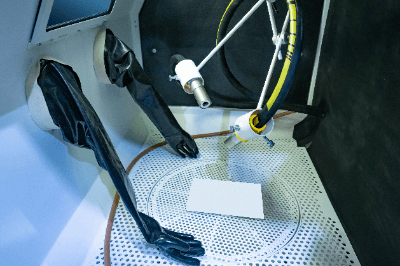What Is an Air Blaster?

Air blasting refers to a technique and equipment for blasting abrasive materials by blowing them with a compressed air-produced compressor.
There are three types of air blasting systems: direct pressure type, blower type, and suction type (gravity type), and they are used according to the material and shape of the workpiece.
Similarly, there are variations in abrasive materials, and the most suitable one is selected according to the object and the intended use. Generally, the suction type is the most commonly used equipment.
Uses of Air Blasting
Air blasting can be used to process a variety of materials, including metal, resin, glass, stone, and wood. Depending on the material and processing application, abrasive materials with different hardness and shapes are used. Various materials are used for abrasives, including metal, glass, and nylon.
The main processes of air blasting are as follows:
- Surface preparation to roughen the surface of the workpiece
- Deburring and precision cutting to remove unnecessary parts of the workpiece
- Surface cleaning and washing
- Polishing (Sirius process) to polish the surface, etc.
Air blasting is also used for peening to increase the strength and stress of metal surfaces by tapping them.
Principle of Air Blasting
Air blasting uses compressed air from a compressor to inject abrasive material onto an object for various types of processing.
Air blasting can be divided into three main types: direct pressure type, suction type, and blower type.
The direct pressure method is the fastest of the three.
The suction method is also called the gravity method. The abrasive is stored inside the machine gun, where compressed air sucks the abrasive and injects it through the nozzle.
The compressed air and the flow of abrasive from the hopper utilize gravity, which is why it is also called the “gravity type.
Using the same principle as an air gun, this is the most commonly used method of air blasting, but the force of the jet is less powerful than the direct pressure type.
The blower type blows the abrasive material with air from a blower fan. Since a compressor is not required, the cost of purchasing a system can be reduced.
However, it is not suitable for processing hard materials due to its low power.
Difference Between Air Blasting and Shot Blasting
The word “blast” means “a strong blow,” but several blast processes depend on the spraying method and type of abrasive. Among these, air blasting and shot blasting are the most common.
The difference is that air blasting blows abrasives with compressed air, while shot blasting uses the powerful centrifugal force generated by an impeller rotating at high speed with a motor.
Shot blasting is more powerful in terms of spraying power and is suitable for rough surface grinding, such as for thermal spraying surface preparation or for removing stubborn rust. On the other hand, air blasting can produce a softer output by adjusting the type and particle size of the abrasive, making air blasting the method of choice for finishing work that requires precision.
Types of Abrasives Used in Air Blasting
Air blasting is also known as “sandblasting” because it uses the force of air to blow a granular abrasive onto the mating material.
The type of material as fine as that “sand” is mainly low specific gravity materials, such as resin and glass (silica sand). Even if abrasive metal materials are used, they are limited to light metals such as alumina.
This is because lightweight materials mix better and can be sprayed more effectively due to the characteristics of air blasting, in which air is mixed with air and sprayed.
On the other hand, shot blasting is used to use high-specific gravity materials, such as stainless steel and zinc, as abrasive materials.
Deburring by Air Blasting
Deburring is one of the processes in which air blasting, which uses low specific gravity, and fine-grained abrasives, excels. Since the treatment is limited to the tip of the nozzle, it is possible to target only the burrs that occur in the details of even complex-shaped mating materials, contributing to quality improvement and labor savings.
In addition to deburring metal gears, this system can also be used for delicate deburring that improves machinability while providing an appropriate radius, like the edge of a tool. By reducing the amount of heat generated by air blasting, deburring can be performed without damaging thermoplastic and thermosetting resins.